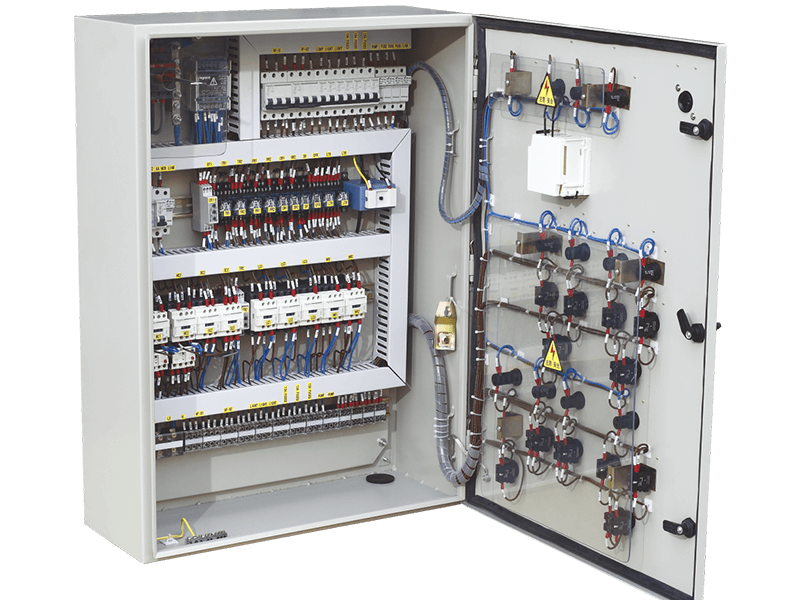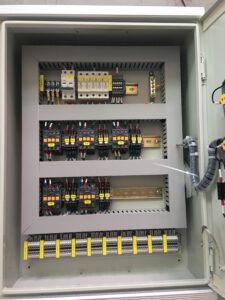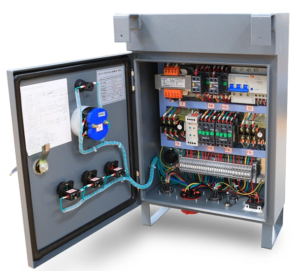
Unveiling the Mysterious Control Box: Your All – in – One Guide
In the intricate realm of electrical operations, nothing functions in isolation. Behind the seamless operation of electrical systems lies an often – overlooked yet crucial element: the control box. This unassuming device serves as the nerve center for managing all connected electrical tools. Whether you’re planning to install a control box in an industrial setting, a commercial establishment, or even in certain residential applications, this comprehensive guide is tailored just for you. In the following pages, we will delve deep into every aspect of the control box, from its basic definition, purpose, different types, applications, and benefits, to its components. So, let’s embark on this enlightening journey of discovery!

1. What Exactly is a Control Box?
A control box stands as one of the fundamental and indispensable components in numerous industrial and commercial operations. At its core, the primary function of an electrical control system is to offer a secure and dedicated space for housing electrical components. It snugly fits these components within its body, shielding them from the harsh external environment and ensuring safe usage. These boxes play a pivotal role in a wide array of activities, ranging from the smooth operation of complex machines and equipment to the enhancement of overall safety standards. In essence, a control box is the central hub that orchestrates the harmonious functioning of electrical systems, making it an essential part of modern infrastructure.
2. The Purpose of a Control Box: More Than Meets the Eye
The control box serves several crucial purposes, with its most basic function being to safeguard electrical components from chaos and potential damage. By encasing these components, it effectively protects them from dust, humidity, and other environmental stressors that could otherwise cause premature wear and tear. Moreover, control boxes act as a vital safety barrier, preventing accidental contact with the electrical systems, which could lead to dangerous situations. This not only ensures the longevity of the electrical parts but also guarantees the safety of personnel in the vicinity.
In addition to protection, control boxes are designed to streamline operations. They can be used to perform a variety of functions, such as switching equipment on and off, precisely controlling the flow of electricity, and monitoring the overall performance of the system. With all these functions integrated into a single, compact unit, the control box simplifies the management of even the most complex machines, making it an invaluable asset in any electrical setup.

3. Types of Control Boxes: A Diverse Range for Every Need
There exists a wide variety of control boxes, each tailored to specific applications and industries. Here are some of the most common types:
i) Electrical Control Boxes
These control boxes are primarily responsible for controlling the distribution of electrical power. They typically house components such as circuit breakers, switches, and relays. In industries where precise power distribution control is essential, such as factories and data centers, industrial electrical control boxes play a vital role. They ensure that electrical power is distributed evenly and safely, preventing overloading and potential electrical hazards.
ii) PLC Control Boxes
Programmable Logic Controller (PLC) control boxes are the backbone of modern automation systems. These boxes contain PLC units that can be programmed to control machines according to predefined processes. They are seamlessly integrated into production systems and industrial structures, enhancing their efficiency and productivity. PLC control boxes are capable of handling complex tasks with precision, making them ideal for industries that require high – level automation, such as automotive manufacturing and food processing.
iii) Motor Control Boxes
As the name implies, motor control boxes are designed specifically for controlling motors. They usually consist of motor starters, overload relays, and other devices that support motor operations. These boxes are widely used in various production industries, including mining and construction. Motor control boxes ensure that motors start and stop smoothly, protect them from overloading, and optimize their performance, thereby increasing the efficiency and lifespan of the motors.
iv) HVAC Control Boxes
In heating, ventilation, and air – conditioning (HVAC) systems, control boxes are used to regulate the temperature, humidity, and air circulation. They are equipped with relevant sensors, relays, and control circuitry. HVAC control boxes play a crucial role in maintaining a comfortable indoor environment, whether it’s in an office building, a hospital, or a residential home. By precisely controlling the HVAC system, they help to reduce energy consumption and improve indoor air quality.
v) Lighting Control Boxes
Lighting control boxes are used to manage the illumination systems in buildings and outdoor spaces. These control systems can be programmed to turn lights on and off at specific times of the day or in response to the availability of natural light. This not only enhances convenience but also contributes to significant energy savings. Lighting control boxes are commonly used in commercial buildings, public spaces, and smart homes, where energy efficiency and lighting management are of utmost importance.
4. Components of a Control Box: The Building Blocks of Functionality
A control box is composed of several key components, each playing a vital role in the proper functioning of the control system:
Enclosure
The enclosure serves as the outer shell of the control box, providing essential protection to the internal components. It shields them from dust, water, and other extreme weather conditions. Enclosures are typically made of either durable metallic materials, such as stainless steel or aluminum, which offer high – strength and corrosion resistance, or strong plastic materials, which are lightweight, cost – effective, and often have good electrical insulating properties.
Circuit Breakers and Fuses
Electrical systems are inherently vulnerable to overloads and short circuits. Circuit breakers and fuses are essential components that safeguard the system by interrupting the current flow when necessary. Fuses, once blown, need to be replaced, while circuit breakers can be reset once the underlying problem is resolved. These components act as the first line of defense against electrical faults, protecting both the equipment and the users from potential hazards.
Switches
Switches are the instruments that enable the manipulation of electrical power flow within the control box. They are crucial for turning devices on and off, as well as for engaging and disengaging various circuits. There are different types of switches, such as toggle switches, push – button switches, and rotary switches, each designed for specific applications and operating requirements.
Relays
A relay is an electrically operated switch that can control multiple electrical loads with a simple electrical signal. It is often an integral part of an automation system, allowing for remote control of equipment. Relays are used in a wide range of applications, from industrial control systems to home automation, as they provide a convenient and efficient way to control electrical circuits without the need for direct physical contact.
Transformers
Transformers are used to adjust the level of electrical power within the control box. They can either step up or step down the voltage, depending on the requirements of the different components. This ensures that the electrical power supplied to each component is at the appropriate level, optimizing their performance and preventing damage due to over – voltage or under – voltage conditions.
Timers
Timers are components that can switch power components on or off at predetermined times or intervals. They are commonly found in lighting control boxes and other applications that require precise timing functions. For example, in a lighting control system, timers can be used to automatically turn on the lights at dusk and turn them off at dawn, or to schedule lighting for specific events or activities.
Terminal Blocks
Terminal blocks are used to neatly connect electrical wires within the control box. They provide a secure and organized way to make electrical connections, facilitating easy modification and maintenance of the system. Terminal blocks are available in different sizes and configurations, depending on the number of wires to be connected and the current – carrying capacity required.
5. Applications of a Control Box: Ubiquitous in Modern Life
Control boxes find applications in a vast number of areas and industries, making them an essential part of modern infrastructure:
Industrial Automation
One of the most significant applications of control boxes is in industrial automation. They are used to control machines and processes, minimizing the need for manual intervention. By integrating control boxes into the production line, manufacturers can achieve higher levels of precision, efficiency, and productivity. Industrial automation with control boxes is prevalent in industries such as manufacturing, robotics, and assembly lines, where consistent and accurate operation is crucial.
Power Distribution
In power distribution systems, control boxes act as key distribution elements, regulating the transmission of electrical energy. They help to ensure that electrical power is delivered safely and efficiently to various end – users. Control boxes also play a vital role in preventing overloading and electrical fires, making them an essential component of any power distribution network.
HVAC Systems
In HVAC systems, control boxes are responsible for maintaining optimal temperature, humidity, and air quality. They control the operation of heating, cooling, and ventilation equipment, ensuring a comfortable and healthy indoor environment. Whether it’s a large commercial building or a small residential home, HVAC control boxes are essential for the efficient operation of the HVAC system.
Lighting Control
Control boxes are widely used in lighting control systems to manage the illumination in buildings and outdoor spaces. By programming the control box, lights can be turned on and off automatically, adjusted according to the time of day or the availability of natural light, or controlled remotely. This not only saves energy but also enhances the convenience and security of the lighting system.
6. Benefits of a Control Box: A Multitude of Advantages
The benefits of using a control box are numerous and far – reaching:
Safety
Safety is one of the primary benefits of a control box. By enclosing electrical components within a well – engineered enclosure, it significantly reduces the risk of accidents and protects people from electrical shocks. Control boxes also help to prevent electrical fires and other hazards, creating a safer working and living environment.
Efficiency
Control boxes enhance the efficiency of electrical systems by centralizing control and management. Instead of having each component operate independently, all electricity – consuming devices are connected to the control box. This allows for easier monitoring, control, and optimization of equipment, reducing downtime and increasing overall productivity.
Protection
The robust construction of control boxes provides excellent protection to electrical and electronic components from external factors such as dust, moisture, and physical damage. This protection extends the operational lifespan of the equipment, reducing the need for frequent repairs and replacements, and ultimately saving costs.
Flexibility
Control boxes come in a variety of shapes, sizes, and designs to meet the diverse needs of different applications. They can also be easily upgraded and modified to adapt to changing requirements. This flexibility makes control boxes a versatile solution for a wide range of electrical control needs.
7. Conclusion: Making the Right Choice
In conclusion, control boxes are the cornerstone of most industries, providing order, safety, and efficiency in the handling of electrical systems. When choosing a control box, it is essential to take the time to assess your specific requirements and select the appropriate type and model. This will help to prevent potential risks that may arise from improper handling of electrical systems.
If you’re in the market for high – quality control boxes, consider Saipwell. Saipwell is a trusted and professional electrical enclosure manufacturer in China, with over 30 years of rich experience. They offer control boxes made from top – grade plastics, stainless steel, metal, and aluminum. What’s more, Saipwell provides customization services, allowing you to tailor the control box according to your specific applications, needs, and budget. With Saipwell, you can be confident in getting a reliable and durable control box that meets your exact requirements. Let Saipwell be your partner in ensuring the smooth and safe operation of your electrical systems!
